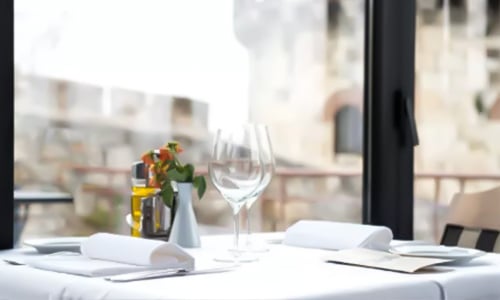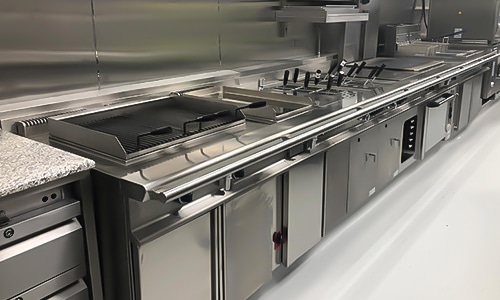How Successfully Run a Restaurant?
After actually starting to run a restaurant, you find that it’s far more difficult than you thought. There are so many things to consider in costing, capital flow, staff management, health and safety, licensing …… Everyone wants to build smooth, efficient and professional restaurants, but many times, these complexities can mess up your thinking. No need to worry, you can consider the following 5 aspects of restaurant operations, they will help you to rationalize your thinking.
You’ll find that in some areas you’ve done a great job and that’s something to be proud of, while perhaps in others you haven’t started building, either way, hopefully you’ll get golden ideas for running a successful restaurant from these tips that Chefmax has summarized and shared.
Table of Contents
1. Provide excellent service
Customers come to a restaurant and expect two most basic things: good food and high level of service.
A. Food
• Look for a consistent supplier of vegetables and meats to maintain consistency. People will remember how they felt the first time they dined and come back later for that feeling. While the chef and recipes remain the same, frequent fluctuations in the flavor of ingredients can still be a major disappointment to customers.
• Update the menu. Even fast food with a single category is regularly introduced with creative and rich new offerings. By making appropriate changes with seasonal updates and consumer feedback, customers will enjoy seeing something new on the menu.

B. Employee management and customer service
• Train friendly and professional employees. It is important to ensure that employees are always friendly and can value and properly meet the needs of customers. Great staff can play a more important role than we can even imagine, and customers will come into direct contact with the busy staff in the restaurant. That’s why you’ll find that some restaurants will make it their specialty to serve to the best of their ability, even offering mouthwash after a meal.
• Encourage employee development. Staff need to know exactly what they are responsible for and not be left out or confused, so you should have a detailed system of rewards and sanctions to promote staff development, reward them generously, and encourage them to voice their ideas and suggestions.

Employees know all the processes in your restaurant better than anyone else and will know where the problems lie, so if you need suggestions on how to run a restaurant and what changes to make that would be more effective, communicate with your staff and work with them to improve the efficiency and quality of service in your restaurant.
• Pay attention to the details. A great dining experience is a cumulative result of every detail: whether every corner of the tableware is clean, whether the tables and tablecloths are clean, and whether the tables are missing napkins and condiment bottles. Additional attention needs to be paid to the fact that if you provide restrooms for customers, the restrooms need to be cleaned and maintained even more, which is also a part of customer service.
2. Establishing an efficient kitchen
From our long experience of studying the commercial kitchen field, we have summarized the following 4 points and assure you of their feasibility.
A. Ensure efficient and smooth operation of equipment
In a busy kitchen, if a piece of equipment breaks down, it can have a huge impact on the operation of the entire kitchen. The gas range won’t light a flame, the dishwasher won’t run, and your staff will have to scrambling to wash dishes…… You can avoid these situations by trying to do two things.
• Choose a trusted supplier for quality equipment and warranty services. Don’t compromise on equipment quality. While low-quality equipment saves money, it also brings low power, incomplete cleaning, high failure rates, unsafe and many other problems. Even though excellent quality usually means a high price, you can still look for cost-effective equipment from a trusted supplier.
This is a very important point, make sure your equipment has full quality certificates and ask the supplier if they have a perfect warranty, this will be an important guarantee for how to run a restaurant.
• Equipment should be checked regularly at the end of business to ensure proper operation next and reduce the probability of breakdowns. It is also a good idea to have one of your employees who knows part of the repair knowledge so that you can try to fix it under professional guidance through video calls and other forms when the repair person cannot arrive in time.

B. Connecting workstations efficiently
There are five services in the kitchen that represent the most basic functions of the kitchen and constitute a complete process: storage, preparation, cooking, serving, and finally cleaning of used dishes. While the efficiency of individual workstations is a concern, the most important thing is to connect each service smoothly.
• The first is the kitchen layout. Choosing the right layout for the size of the kitchen and type of restaurant will greatly improve efficiency. There are four most common commercial kitchen layouts.
An assembly line layout in which ingredients form a complete line from removal, preparation to completion of cooking, suitable for repeated production of a large number of the same type of dishes.
Island-type layouts suitable for restaurants with square kitchens and large spaces, with clear partitions for easy communication.
Separate areas for different types of dishes, suitable for a zone-type layout for restaurants with large menus.
Commercial kitchen equipment placed along two parallel wall biscuits, a parallel type layout suitable for rectangular kitchens with large space.
• Optimize the order in which workstations are connected. Storage and preparation areas should be located away from the door so that they do not interfere with staff serving meals; preparation and cooking areas can be set up together to ensure that those chopped ingredients can be cooked quickly; storage and cleaning areas should not be too close to each other to prevent used dishes or cleaning solutions from contaminating stored ingredients.
C. Establish an inventory record system
Everything in the kitchen (food, spices, disposable gloves, but also consumables in the dining area) needs to be included in the inventory management system and updated daily or weekly, which can better help to account for costs, consumption and timely replenishment. The most important thing is to follow the FIFO principle and consume those ingredients with a short shelf life in a timely manner to reduce waste and thus save costs. After you start doing this, you will realize that it is a very important part of “how to run a restaurant“.
A dedicated employee can be assigned to confirm and record inventory at the end of each day’s business.
D. Prepare semi-finished products and ingredients in advance
You can increase productivity by not only increasing the output of your equipment, but you can save a lot of time in a busy kitchen and reduce the stress of your staff during peak hours if you have something to prepare in advance for each step of the process.
Preparing toppings, sauces, removing the skins from potatoes and carrots, cleaning and setting up tools before you open for business are things most kitchens are doing.
3. Manage the numbers accurately
A. Active accounting
Accurate costing can help you budget, deal with price fluctuations and save costs to the greatest extent possible. We all know this is a daunting task, with so many things to be taken into account, the cost of ingredients, staff salaries, the cost of acquiring and maintaining equipment, energy costs and so on.
Of course, reducing costs must not mean reducing quality.
You can divide these into fixed costs and variable costs. Fixed costs are difficult to save, such as rent, staff wages and the cost of maintaining licenses, while the probability of being able to save is much higher. You can save on utility expenses by using energy-efficient equipment and training staff to be conscious of savings, or you can negotiate a long-term partnership with suppliers to reduce the cost of ingredients.

B. Prepare sufficient capital for cycle flow
In the early stages of running a restaurant, it can be difficult to recoup all of your investment quickly. It usually takes a long time to recover the money, and every restaurant needs to consider the situation that the expenses will not be fully recovered in 6-12 months in the early stage of opening, and many restaurants have closed down because the money cannot flow.
If your restaurant has entered a smooth running phase, please also note that you should plan on a cycle, restaurant revenue will be affected by the season, temperature, tourist season, festivals of all kinds, please make sure your capital can support the restaurant through the off-season, do not consider too high expenses before then.
C. Prudent pricing
Depending on the type of restaurant, which pricing model do you want to choose? A snack bar model with low margins or a fine dining model with service fees included, either one needs to be considered based on the results of market research. Deciding on a price is really a marketing strategy; low prices will attract crowds while increasing competitiveness, but with low margins and high prices that may turn some people away, it can be a difficult task to weigh the two.
Most merchants have pricing models that are worth considering, and they choose different pricing models for different products (sometimes those used to attract crowds only pay for themselves) and make adjustments based on sales.
4. Expanding business
A. Expand the dining area
When your business is on the rise, providing more seating can help run a restaurant, but obviously changing the layout of the restaurant to add more tables and chairs is not practical and may increase crowding or reduce the dining atmosphere.
If you have enough money, consider opening a branch, but most of the time you just need to add terraces outside your restaurant to provide open dining areas, and this way it is also better for your restaurant to be seen by people passing by (customers enjoying great food are the best sign).
B. Seize the opportunity
It’s not easy to maintain your current size. Even if you want to maintain the status quo, the restaurant situation will always be influenced or even left behind by the market or perception, so keeping up with the times is a grounding method that every restaurant owner needs to learn.
Nowadays, the trend of running restaurants is changing drastically under the influence of the pandemic, with ghost kitchens and contactless ordering starting to take off, and automated equipment and technology being adopted more often to solve labor shortage problems. Even though some say it’s a harsh winter in the restaurant industry, the industry will always progress and change to adapt to the times.
If you choose digital QR code menus or contactless payments, read on for the next section on investing in technology and you’ll learn which technologies restaurants need to invest in in order to keep up with the times.

C. Invest in technology
• In 2022, most restaurants choose to use contactless payments (including mobile wallet payments and QR code payments). Offering online ordering means you will need to register on a platform or create your own restaurant website, which requires an investment to maintain.
• Nearly three-quarters of restaurants face labor shortages, and replacing fully automated equipment can effectively reduce staffing needs, but again, this requires a significant outlay, which can be helped on the technology side by automating online orders through delivery apps and automating customer payments.
5. Try to market your concept
Marketing is one way to help you run a restaurant. For a long time, restaurants may have relied on signs and customers promoting each other to get new customers, but with the times, you’ve seen how powerful social media can be. The first step in getting started with marketing is to define a distinct, personal concept for your restaurant.
A. Define the brand concept
What is your restaurant’s main focus, fast food or low-fat meals? Or maybe the decoration style is simple or lively? After defining this concept, a series of packages need to be developed around the positioning, the first experience of your customers with your business. This means that your restaurant should be enjoyable from the moment the customer walks through the door. This includes music, ambiance, cleanliness, service style, look and feel of the menu, and more. These are the brand concepts that belong to your restaurant.

B. Invest more in social media
Twitter, Facebook,Tiktok, social media has advanced more than you can imagine. When people dine out, the first thing they do is search for relevant information on the internet. Trust me, your restaurant doesn’t necessarily need to post beautiful photos and food, people prefer to see the real and genuine thing, so an authentic restaurant visit experience is always a great way to promote your restaurant, but remember to always keep your distinctive character.
C. Integration into the community
Restaurants exist in the community and are relevant to everyone in it. It is the place where many important life events take place, and the greater the role you play in the community, the closer you will be to your customers, which is why many restaurants are so keen to get involved in community events.
Communities often hold food fairs, which is a great opportunity to get to know your restaurant. In addition to this, many restaurants choose to provide free food to those they serve in the community, make charitable donations to community organizations, etc., all of which demonstrate the restaurant’s positivity and responsibility.
Summary
Decision makers need to keep their heads above water. Running a restaurant is no easy task and all your decisions need to be based on a good understanding of the current situation, but don’t worry too much, you usually have a certain amount of trial and error. Passion and love are important, but a well-thought-out operational plan is also essential. Chefmax will provide all the professional help you need in the commercial restaurant kitchen, and no matter what, success is always in your hands.
























